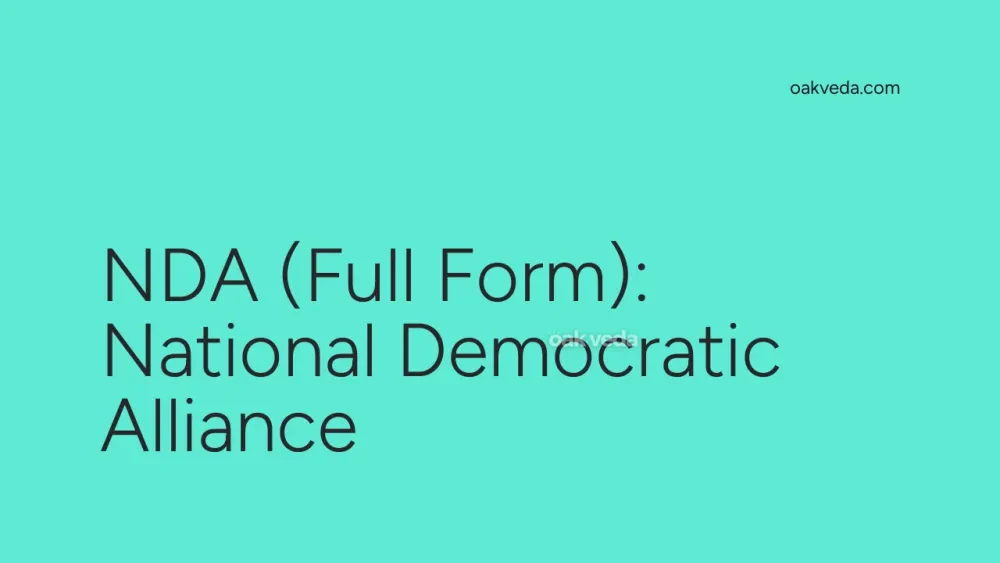
What is the Full Form of NDA?
The full form of NDA is National Democratic Alliance. In the context of Indian politics, NDA refers to a coalition of political parties led by the Bharatiya Janata Party (BJP). However, it's worth noting that NDA can also stand for National Defence Academy in a military context.
What is National Democratic Alliance?
The National Democratic Alliance (NDA) is a prominent political coalition in India. Formed in 1998, it represents a group of right-wing and centrist political parties that come together to contest elections and form governments at both the national and state levels. The NDA has played a significant role in shaping India's political landscape over the past two decades.
Origin and Development of National Democratic Alliance
The NDA was established in 1998 as a response to the growing need for coalition politics in India. The alliance was formed under the leadership of the Bharatiya Janata Party (BJP), which remains its largest and most influential member. The coalition's first taste of power came in the same year when it formed the government at the center, with Atal Bihari Vajpayee becoming the Prime Minister.
Since its inception, the NDA has evolved significantly. It has seen parties join and leave the alliance based on political circumstances and regional dynamics. Despite these changes, the coalition has managed to maintain its relevance in Indian politics, winning multiple national elections and forming governments in several states.
How does the National Democratic Alliance work?
The NDA functions as a collective of like-minded political parties that share common goals and ideologies. The alliance works on the principle of consensus, where member parties come together to:
- Formulate common minimum programs
- Decide on seat-sharing arrangements for elections
- Coordinate campaign strategies
- Form governments and allocate ministerial berths when in power
The BJP, as the largest party, often takes the lead in these processes, but other alliance partners also have a say in decision-making.
Types of Parties in the National Democratic Alliance
The NDA comprises various types of political parties:
- National Parties: Like the BJP, which has a presence across multiple states
- Regional Parties: Such as the AIADMK in Tamil Nadu or the Lok Janshakti Party in Bihar
- State-specific Parties: For example, the Mizo National Front in Mizoram
This diverse composition allows the NDA to have a pan-India presence while also addressing regional aspirations.
Functions of the National Democratic Alliance
The primary functions of the NDA include:
- Electoral Coordination: Ensuring member parties don't compete against each other in elections
- Policy Formulation: Developing common policies and programs when in government
- Opposition Strategy: Coordinating efforts to challenge the ruling party when in opposition
- Regional Representation: Providing a platform for regional parties to have a voice at the national level
Applications of the National Democratic Alliance Model
The NDA model of political alliance has several applications:
- Governance: Forming stable governments at the center and in states
- Representation: Ensuring diverse regional interests are represented at the national level
- Policy Implementation: Facilitating the implementation of policies across different states
- Political Stability: Contributing to political stability by creating broad-based coalitions
Features of the National Democratic Alliance
Key features of the NDA include:
- BJP-led Coalition: The BJP is the largest and most influential member
- Ideological Alignment: Most members share right-wing or center-right ideologies
- Flexible Membership: Parties can join or leave based on political circumstances
- Pan-India Presence: The alliance has representation across various regions of India
- Shared Governance: When in power, alliance members share ministerial positions
Benefits of the National Democratic Alliance
The NDA offers several benefits to its members and the political system:
- Electoral Advantage: Pooling of resources and vote banks
- Diverse Representation: Bringing together parties from different regions
- Stable Governance: Providing a platform for forming stable governments
- Policy Consensus: Facilitating agreement on key policy issues
- National Integration: Promoting national integration through political cooperation
Limitations or Challenges of the National Democratic Alliance
Despite its successes, the NDA faces several challenges:
- Ideological Differences: Managing diverse ideologies within the alliance
- Power Sharing: Balancing the interests of various alliance partners
- Regional vs. National Interests: Reconciling regional aspirations with national policies
- Coalition Management: Maintaining unity and resolving conflicts among members
- Opposition from Other Alliances: Competing with other political coalitions like the United Progressive Alliance (UPA)
Future Developments in the National Democratic Alliance
The future of the NDA is likely to be shaped by several factors:
- Evolving Political Landscape: Adapting to changing voter preferences and emerging issues
- Regional Dynamics: Managing the growing assertiveness of regional parties
- Leadership Transition: Preparing for future leadership changes within the BJP and other member parties
- Policy Challenges: Addressing key national issues like economic growth, social welfare, and foreign policy
- Electoral Strategies: Developing new strategies to maintain and expand the alliance's electoral base
FAQs on NDA Full Form
-
What is the primary full form of NDA in Indian politics? The primary full form of NDA in Indian politics is National Democratic Alliance.
-
When was the NDA formed? The National Democratic Alliance was formed in 1998.
-
Which party leads the NDA? The Bharatiya Janata Party (BJP) leads the National Democratic Alliance.
-
Who was the first Prime Minister from the NDA? Atal Bihari Vajpayee was the first Prime Minister from the NDA, serving from 1998 to 2004.
-
Can you name some current members of the NDA? Current members include the BJP, Lok Janshakti Party, AIADMK, and Janata Dal (United), among others.
-
Is the NDA currently in power at the national level? Yes, as of 2023, the NDA is in power at the national level, led by Prime Minister Narendra Modi of the BJP.
-
What is another full form of NDA? Another full form of NDA is National Defence Academy, which is India's joint defence services training institution.
You may be interested in:

